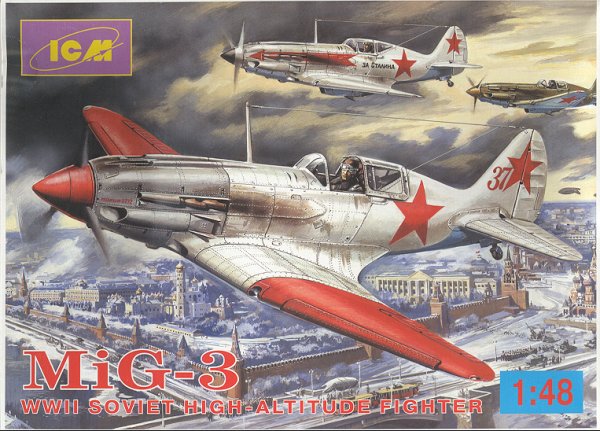
|
KIT: |
ICM 1/48 Mig-3 |
|
KIT # |
48051 |
|
PRICE: |
$19.95 |
|
DECALS: |
eleven aircraft |
|
REVIEW & |
|
|
NOTES: |
|

|
HISTORY |
The MiG-3 was the first successful fighter in a long line of aircraft from the design team of Mikoyan and Gurevich. It was designed as a high altitude interceptor. A rather odd choice if you think about it. However, the Soviet Union was convinced that hordes of high altitude strategic bombers were a real possibility and so developed an aircraft to combat this perceived threat. Very much like the MiG-25 was developed to combat the threat of a high altitude supersonic bomber, the B-70. An aircraft that was never developed and so the threat never materialized.
Designed for speed and climbing abilities, the MiG-3 was first flown in early 1941. It was a proficient aircraft in the hands of a well trained pilot. Unfortunately, most of the air war during the Great Patriotic War was at low level, an area where the MiG-3 was at a distinct disadvantage. The Germans preferred to fight at lower altitudes as most bombing was of a tactical nature against troops and tanks and not strategic. Nevertheless, the MiG-3 was able to score some kills. With the realization that the high altitude threat wasn't there, production of the MiG-3 was curtailed in 1942 after only a relatively short production run. The type soldiered on in some of the backwaters of the war and by 1944 had pretty well disappeared from service.
|
THE KIT |

This is only the third 1/48 MiG-3 to be available on the market and one of the few ICM kits that hasn't been done in multiple boxings. As with the previous Yak and Spitfire kits, it offers a fully detailed interior and complete engine. There are a number of removable panels to allow you to look at your handiwork. Options are pretty well limited to either rockets or gun pods under the wings.
Molded in dirty white plastic, the kit is nearly free of the massive numbers of sink marks found in their initial offerings of the Spitfire and P-51 kits. The only sink marks I could find were on the backs of the prop blades, the inner upper wing, and in the one-piece rudder. The canopy is a three-part construct and in my kit was badly scratched and not very clear. In fact, like the white styrene, it has a dingy cast to it as if it were smoked glass.
The kit offers separate slats, ailerons and rudder, though they really cannot be
positioned in any way other than straight ahead without modification. The wing
to fuselage assembly looks rather complicated. You have separate wing root
fairings as well as several different sections to the forward lower wing. The
wing itself is five major pieces; each outer wing is two pieces and there is a
separate lower wing section. Add to this the wing root fairing and the forward
under section pieces and you'll have to be very careful in fitting and
construction on this one!
The instructions are quite good and offer a number of color cross-references including Humbrol and Testors paints. There are markings for no less than eleven aircraft, five of them in overall white. Unfortunately, they are all profiles except for the box art plane, which is on the back cover. This means you'll have to find a reference for the upper wing camo for five of the schemes. The decals are well printed and quite matte. ICM decals are not bad, but were I you, I'd opt for an aftermarket sheet as ICM's offerings have proven to be totally unimpressed with any setting solutions and will not snuggle into any panel lines. There is at least one Aeromaster sheet for the MiG-3. I'd recommend getting it while the getting is good.
|
CONCLUSIONS |
I dare say that this is probably the best you are going to get when it comes to 1/48 MiG-3 kits. I have seen them built into stunners, so it isn't impossible, but will take careful construction. Tom Cleaver did a build article on this kit that you may find useful. I plan to use it as a guide when I do mine!
Review kit courtesy of my kit collection
If you would like your product reviewed fairly and quickly by a site that has well over 100,000 visitors a month, please contact me or see other details in the Note to Contributors.